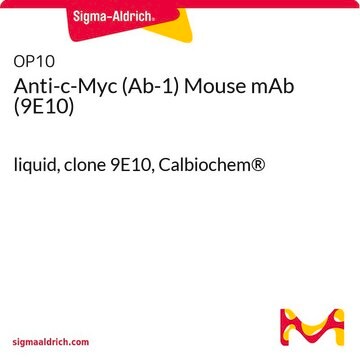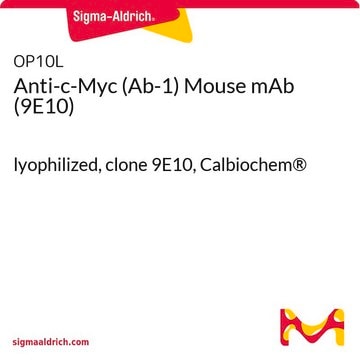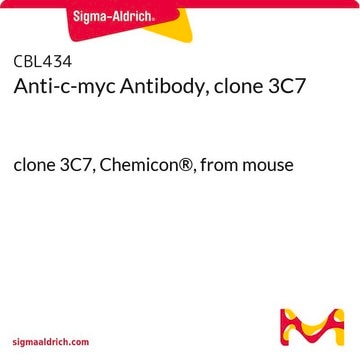OP13
Anti-N-Myc Mouse mAb (NCM II 100)
liquid, clone NCM II 100, Calbiochem®
Sign Into View Organizational & Contract Pricing
All Photos(1)
About This Item
UNSPSC Code:
12352203
NACRES:
NA.43
Recommended Products
biological source
mouse
Quality Level
antibody form
purified antibody
antibody product type
primary antibodies
clone
NCM II 100, monoclonal
form
liquid
does not contain
preservative
species reactivity
human, mouse
manufacturer/tradename
Calbiochem®
storage condition
OK to freeze
avoid repeated freeze/thaw cycles
isotype
IgG1
shipped in
wet ice
storage temp.
−20°C
target post-translational modification
unmodified
Gene Information
human ... MYCN(4613)
General description
Purified mouse monoclonal antibody generated by immunizing BALB/c mice with specified immunogen and fusing splenocytes with SP2/0 mouse myeloma cells (see application references). Recognizes N-myc and its cleavage products.
Recognizes the N-myc protein and its cleavage product in IMR5 cells.
This Anti-N-Myc Mouse mAb (NCM II 100) is validated for use in Frozen Sections, Immunoblotting, Immunofluorescence, Immunoprecipitation for the detection of N-Myc.
Immunogen
Human
recombinant, human, N-myc fusion protein, expressed in E. coli
Application
Frozen Sections (1-5 µg/ml)
Immunoblotting (1-5 µg/ml, see application references)
Immunofluorescence (1-5 µg/ml, see application references)
Immunoprecipitation (1-2 µg/sample, see application references)
Immunoblotting (1-5 µg/ml, see application references)
Immunofluorescence (1-5 µg/ml, see application references)
Immunoprecipitation (1-2 µg/sample, see application references)
Packaging
Please refer to vial label for lot-specific concentration.
Warning
Toxicity: Standard Handling (A)
Physical form
In 50 mM sodium phosphate buffer, 50% glycerol.
Reconstitution
Following initial thaw, aliquot and freeze (-20°C).
Analysis Note
Positive Control
IMR5 cells
IMR5 cells
Other Notes
Brondyk, W.H. 1991. Oncogene6, 1269.
Ikegaki, N., et al. 1988. Adv. Neuroblastoma Research.2, 133.
LeGouy, E., et al. 1987. In Nuclear Oncogenes, Cold Spring Harbor Laboratory, 144.
Cole, M.D., 1986. Ann. Rev. Gen.20, 361.
Ikegaki, N., et al. 1986. Proc. Natl. Acad. Sci. USA83, 5929.
Slamon, D.J., et al. 1986. Science232, 768.
Seeger, R.C., et al. 1985. New Engl. J. Med.313, 1111.
Brodeur, G.M., et al. 1984. Science224, 1121.
Michitsch, R.W., et al. 1984. Mol. Cell. Biol.11, 2370.
Kohl, N.E., et al. 1983. Cell35, 603.
Schwab, M., et al. 1983. Nature305, 245.
Ikegaki, N., et al. 1988. Adv. Neuroblastoma Research.2, 133.
LeGouy, E., et al. 1987. In Nuclear Oncogenes, Cold Spring Harbor Laboratory, 144.
Cole, M.D., 1986. Ann. Rev. Gen.20, 361.
Ikegaki, N., et al. 1986. Proc. Natl. Acad. Sci. USA83, 5929.
Slamon, D.J., et al. 1986. Science232, 768.
Seeger, R.C., et al. 1985. New Engl. J. Med.313, 1111.
Brodeur, G.M., et al. 1984. Science224, 1121.
Michitsch, R.W., et al. 1984. Mol. Cell. Biol.11, 2370.
Kohl, N.E., et al. 1983. Cell35, 603.
Schwab, M., et al. 1983. Nature305, 245.
It is important to compensate for the short half life of this protein when preparing tissue sections or extracts. We recommended that all preparations be kept cold and that a cocktail of protease inhibitors be used. Antibody should be titrated for optimal results in individual systems.
Legal Information
CALBIOCHEM is a registered trademark of Merck KGaA, Darmstadt, Germany
Not finding the right product?
Try our Product Selector Tool.
Storage Class Code
10 - Combustible liquids
WGK
WGK 3
Certificates of Analysis (COA)
Search for Certificates of Analysis (COA) by entering the products Lot/Batch Number. Lot and Batch Numbers can be found on a product’s label following the words ‘Lot’ or ‘Batch’.
Already Own This Product?
Find documentation for the products that you have recently purchased in the Document Library.
H P Wang et al.
Journal of virology, 72(3), 2192-2198 (1998-03-14)
Cell line WH44KA is a highly malignant woodchuck hepatoma cell line. WH44KA cells contain a single woodchuck hepatitis virus (WHV) DNA integration in the 3' untranslated region of exon 3 of the woodchuck N-myc1 gene. The highly rearranged WHV DNA
James Chappell et al.
Genes & development, 27(7), 725-733 (2013-04-18)
Suppression of extracellular signal-regulated kinase (ERK) signaling is an absolute requirement for the maintenance of murine pluripotent stem cells (mPSCs) and requires the MYC-binding partner MAX. In this study, we define a mechanism for this by showing that MYC/MAX complexes
S K Radhakrishnan et al.
Oncogene, 27(5), 694-699 (2007-08-29)
We have previously described the identification of a nucleoside analog transcriptional inhibitor ARC (4-amino-6-hydrazino-7-beta-D-ribofuranosyl-7H-pyrrolo[2,3-d]-pyrimidine-5-carboxamide) that was able to induce apoptosis in cancer cell lines of different origin. Here, we report the characterization of ARC on a panel of neuroblastoma cell
Arianna Sabò et al.
PloS one, 9(3), e91072-e91072 (2014-03-13)
Myc-family proteins are key controllers of the metabolic and proliferative status of the cell, and are subjected to a complex network of regulatory events that guarantee their efficient and fast modulation by extracellular stimuli. Hence, unbalances in regulatory mechanisms leading
Luca Montemurro et al.
Cancer research, 79(24), 6166-6177 (2019-10-17)
Approximately half of high-risk neuroblastoma is characterized by MYCN amplification. N-Myc promotes tumor progression by inducing cell growth and inhibiting differentiation. MYCN has also been shown to play an active role in mitochondrial metabolism, but this relationship is not well
Our team of scientists has experience in all areas of research including Life Science, Material Science, Chemical Synthesis, Chromatography, Analytical and many others.
Contact Technical Service








